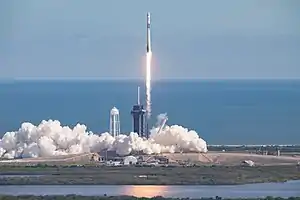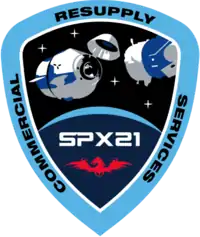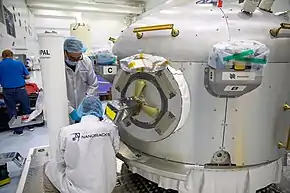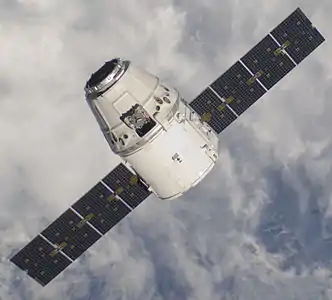SpaceX CRS-21
SpaceX CRS-21, also known as SpX-21, was a Commercial Resupply Service mission to the International Space Station which launched on 6 December 2020.[1][2] The mission was contracted by NASA and was flown by SpaceX using a Cargo Dragon 2. This was the first flight for SpaceX under NASA's CRS Phase 2 contract awarded in January 2016. This was also the first Cargo Dragon of the new Dragon 2 variant, as well as the first Cargo Dragon flight that is docked at the same time as a Crew Dragon spacecraft (SpaceX Crew-1). This mission used Booster B1058.4, becoming the first NASA mission to reuse a booster previously used on a non-NASA mission. This was also first time SpaceX launched a NASA payload on a booster with more than one previous flight.[7][8]
 CRS-21 launches from LC-39A | |
| Names | SpX-21 |
|---|---|
| Mission type | ISS resupply |
| Operator | SpaceX |
| COSPAR ID | 2020-093A |
| SATCAT no. | 47233 |
| Mission duration | 38 days, 9 hours, 9 minutes |
| Spacecraft properties | |
| Spacecraft | Cargo Dragon C208 |
| Manufacturer | SpaceX |
| Launch mass | 6,000 kg (13,000 lb) |
| Payload mass | 2,972 kg (6,552 lb) |
| Dimensions | Height: 8.1 m (27 ft) Diameter: 4 m (13 ft) |
| Start of mission | |
| Launch date | 6 December 2020, 16:17:08 UTC[1][2] |
| Rocket | Falcon 9 Block 5 B1058.4 |
| Launch site | Kennedy Space Center, LC-39A |
| Contractor | SpaceX |
| End of mission | |
| Recovered by | GO Navigator[3] |
| Landing date | 14 January 2021, 01:26 UTC[4] |
| Landing site | Gulf Coast |
| Orbital parameters | |
| Reference system | Geocentric orbit |
| Regime | Low Earth orbit |
| Inclination | 51.66° |
| Docking with ISS | |
| Docking port | Harmony zenith |
| Docking date | 7 December 2020, 18:40 UTC[5] |
| Undocking date | 12 January 2021, 14:05 UTC[6] |
| Time docked | 35 days, 19 hours, 25 minutes |
| Cargo | |
| Mass | 2,972 kg (6,552 lb) |
| Pressurised | 1,882 kg (4,149 lb) |
| Unpressurised | 1,090 kg (2,400 lb) |
 SpaceX CRS-21 mission patch | |
Cargo Dragon
SpaceX plans to reuse the Cargo Dragons up to five times. The new Cargo Dragon spacecraft can haul about 20% more cargo volume than previous Dragon supply ships. It was launched without seats, cockpit controls, the life support system required to sustain astronauts in space and SuperDraco abort engines.[9][10] This newer design provides several benefits, including a faster process to recover, refurbish and re-fly versus the earlier Dragon CRS design used for ISS cargo missions.[11]
While CRS-21 was for a standard 30 days mission, the most recent Flight Planning Integration Panel (FPIP) document indicates that beginning with CRS-23, SpaceX cargo missions will begin to stretch out to 60 days and beyond.[12] Sarah Walker, director of Dragon mission management at SpaceX, said "the new Cargo Dragon can stay at the space station for up to 75 days, more than twice as long as the first-generation Dragon spacecraft".[13]
With this mission, this was the first time that two Dragon capsules was docked at the ISS at the same time.
Beginning with the CRS-21 mission, the new Dragon Cargo capsules splash down under parachutes off the coast of Florida in either the Atlantic Ocean or Gulf of Mexico, rather than the previous recovery zone in the Pacific Ocean west of Baja California.[14] This NASA preference was added to CRS-2 awards.[10][11]
Mission
Timeline
T+00:00: Liftoff
T+01:18: Maximum aerodynamic pressure
T+02:30: First stage main engine cutoff (MECO)
T+02:34: Stage separation
T+02:41: Second stage engine start
T+06:37: First stage entry burn begins
T+08:38: Second stage engine cutoff (SECO)
T+08:38: First stage landing on drone ship
T+11:49: Dragon separation
T+12:35: Dragon nose cone open sequence begins
Primary payload
NASA contracted for the CRS-21 mission from SpaceX and therefore determines the primary payload, date of launch, and orbital parameters for the Cargo Dragon. The CRS-21 mission carries 2,972 kg (6,552 lb) of cargo to ISS.[15][16][17]
- Science investigations: 953 kg (2,101 lb)
- Vehicle hardware: 317 kg (699 lb)
- Crew supplies: 364 kg (802 lb)
- Spacewalk equipment: 120 kg (260 lb)
- Computer resources: 46 kg (101 lb)
- Russian hardware: 24 kg (53 lb)
- External payload (Nanoracks Bishop Airlock): 1,090 kg (2,400 lb)

Nanoracks Bishop Airlock, formerly known as Bishop Airlock Module, is a small commercial airlock module attached to the Tranquility module of the ISS.[18][19] The Nanoracks Bishop Airlock will offer five times the satellite deployment volume than current opportunities (Japanese Kibō module airlock) available today. Nanoracks is the prime contractor, with Thales Alenia Space manufacturing the pressurized shell and Boeing providing the berthing mechanism.[20] It will be the second commercial module of the ISS after the Bigelow Expandable Activity Module (BEAM), which was attached to the ISS in April 2016 and is expected to stay at the ISS until at least 2028. It will add another airlock to the ISS's plethora of airlocks. It was under construction beginning in 2015, and is currently on the Dragon docked to ISS.
BioAsteroid is an experiment designed to test the infrastructure and tools needed for asteroid, lunar, and martian rock mining. It will mine basalt from those bodies for exploration when humans eventually land on them.
Hemocue is a test of the system for white blood cell testing on the Moon and Mars. The systems were developed under Earth's gravity, and still need to be tested in zero-g's.
The Brain Organoid experiment is a continuation of the first Brain Organoid experiment. Its goal is to validate the first round of experiments and to continue the research recorded during those first tests. The program studies the early developed human brain, its movements in microgravity, and can help address and create better models of neurodegenerative disorders.
Cardinal Heart is a continuation of a previous experiment. This experiment will study cardiomyocytes in human heart tissue and its reaction to a zero-g environment. NASA Astronaut Kate Rubins was present for the experiment on station a few years ago, and she said that, paraphrased, few things on station make her gasp, but this is one thing that does.
Subsa-Brains studies the effects of micrometeorites and space junk and the damage they can cause, as well as the process to repair the tissue, called brazing, and if it still works in a zero-gravity environment.
Three-Dimensional Microbial Monitoring (3DMM) is a project that aims to construct a three-dimensional map of bacteria and metabolites that are present at various locations throughout the ISS, and determine how the spaceflight environment affects the various species identified.
Monoclonal Crystal Research in Microgravity (MCRM) is a protein crystallization experiment by the American pharmaceutical company Bristol Myers Squibb. NASA astronauts will study the crystallization of monoclonal antibodies in space, with the aim of improving drug formulation and delivery for patients on Earth. Monoclonal antibodies are lab-created proteins designed to interact with specific targets, called antigens. Monoclonal antibodies are used in the treatment of numerous diseases, including cancer.[21]
Rodent Research-23 (RR-23), will study the effects of spaceflight on the eyes, specifically on the structure and function of the arteries, veins, and lymphatic vessels that are needed to maintain vision.
The CRS-21 pressurized capsule carries a variety of other research including studies on how space conditions affect the interaction between microbes and minerals.[19]
Returning hardware
Beginning with returning capsules or lifting bodies under the CRS-2 contract, NASA reports major hardware (failed or expended hardware for diagnostic assessment, refurbishment, repair, or no longer needed) returning from the International Space Station. The SpaceX CRS-21 mission ended in January 2021 with re-entry into Earth's atmosphere and splash down near the western coast of Florida with 2,002 kg (4,414 lb) of return cargo. This cargo will include:[15]
Treadmill Data Avionics Unit: Failed avionics unit that supports the treadmill, a critical item returning to the ground following the on-orbit replacement with a good spare.
Carbon Dioxide Removal Assembly (CDRA) Air Selector Valve: Critical degraded valve returning for repair and refurbishment to support the carbon dioxide removal capability on-orbit.
Nitrogen Oxygen Recharge System (NORS) Tank: Depressurized tank capable of flying oxygen or nitrogen, and will be utilized for future on-orbit demand in 2021.
Rodent Research Habitats and Transporters: Live rodents from the Rodent Research-23 (RR-23) mission and used habitats and transporters that support future research missions and analysis.
Minus Eighty Laboratory Freezer for ISS (MELFI) Electronics Unit: Failed cold stowage item requiring ground repair to enable future cold stowage missions.
Thermal Amine Bulk Water Save Valve: Failed valve that supports efficient usage of the Thermal Amine system returning to ground for repair, will help inform robustness of similar valve design on Orion capsule.
Undocking and return
Before the heading for re-entry, the automated cargo capsule undocked from the International Space Station (ISS) on 12 January 2021 at 14:05 UTC. The new Dragon design can automatically dock and undock at the station, while the first-generation Dragon cargo freighters were grappled by the station's robotic arm. The undocking and splashdown marked the first return of a Cargo Dragon spacecraft, and wrapped up the first flight of SpaceX Dragon 2 supply spacecraft derived from the Crew Dragon spacecraft. SpaceX recovery teams were on standby for the parachute-assisted splashdown on 14 January 2021 at 01:26 UTC in the Gulf of Mexico, at west of Tampa, Florida. The Dragon returned to Earth with 2,002 kg (4,414 lb) of cargo, according to NASA.[4]
References
- Clark, Stephen (27 November 2020). "Launch Schedule: SpaceX CRS-21". Spaceflight Now. Retrieved 5 December 2020.
- @SpaceX (5 December 2020). "... poor weather in the recovery area for today's attempt" (Tweet) – via Twitter.
- Herridge, Linda (14 January 2021). "Teams Work Overnight to Return Time-Sensitive Cargo From Space". NASA. Retrieved 14 January 2021.
- Clark, Stephen (14 January 2021). "French wine, live rodents among 2 tons of cargo returned from space station". Spaceflight Now. Retrieved 14 January 2021.
- Garcia, Mark (7 December 2020). "New SpaceX Cargo Dragon Docks to Station". NASA.
 This article incorporates text from this source, which is in the public domain.
This article incorporates text from this source, which is in the public domain. - Garcia, Mark (12 January 2021). "Cargo Dragon Undocks from Station and Heads for Splashdown". NASA. Retrieved 12 January 2021.
 This article incorporates text from this source, which is in the public domain.
This article incorporates text from this source, which is in the public domain. - Ralph, Eric (9 June 2020). "SpaceX wins NASA approval to launch astronauts on reused rockets and spacecraft". teslarati.com. Retrieved 10 June 2020.
- "SpaceX CRS-21 Mission Overview" (Press release). ISS National Lab. 17 November 2020.
 This article incorporates text from this source, which is in the public domain.
This article incorporates text from this source, which is in the public domain. - Ralph, Eric. "Dragon 2 modifications to Carry Cargo for CRS-2 missions". Teslarati. Retrieved 29 September 2020.
- Audit of Commercial Resupply Services to the International Space Center (PDF). Office of Inspector General (Report). IG-18-016. NASA. 26 April 2018. pp. 24, 28–30. Retrieved 29 September 2020.
 This article incorporates text from this source, which is in the public domain.
This article incorporates text from this source, which is in the public domain. - Clark, Stephen (2 August 2019). "SpaceX to begin flights under new cargo resupply contract next year". Spaceflight Now. Retrieved 29 September 2020.
- Gebhardt, Chris (20 June 2019). "Station Planning New Crew Launch Dates". NASASpaceFlight.com. Retrieved 29 September 2020.
- Clark, Stephen (6 December 2020). "SpaceX launches first in new line of upgraded space station cargo ships". Spaceflight Now. Retrieved 6 December 2020.
- Clark, Stephen (12 January 2021). "Cargo Dragon heads for splashdown off Florida's west coast". Spaceflight Now. Retrieved 14 January 2021.
- "SpX-21 Mission Overview" (PDF). NASA. 26 November 2020. Retrieved 4 December 2020.
 This article incorporates text from this source, which is in the public domain.
This article incorporates text from this source, which is in the public domain. - "ISS Research Program". Glenn Research Center. NASA. 1 January 2020. Retrieved 29 September 2020.
 This article incorporates text from this source, which is in the public domain.
This article incorporates text from this source, which is in the public domain. - "SpaceX Commercial Resupply". ISS Program Office. NASA. 1 July 2019. Retrieved 27 September 2020.
 This article incorporates text from this source, which is in the public domain.
This article incorporates text from this source, which is in the public domain. - "Nanoracks Bishop Airlock". Nanoracks. Retrieved 29 September 2020.
- Cawley, James (16 October 2020). "Next-Generation Airlock Prepped for SpaceX CRS-21 Launch". Kennedy Launch Services Program. NASA. Retrieved 19 October 2020.
 This article incorporates text from this source, which is in the public domain.
This article incorporates text from this source, which is in the public domain. - Krebs, Gunter (11 February 2020). "Bishop". Gunter's Space Page. Retrieved 29 September 2020.
- CRS-21 Mission (YouTube Video). SpaceX. 6 December 2020.

.jpg.webp)

